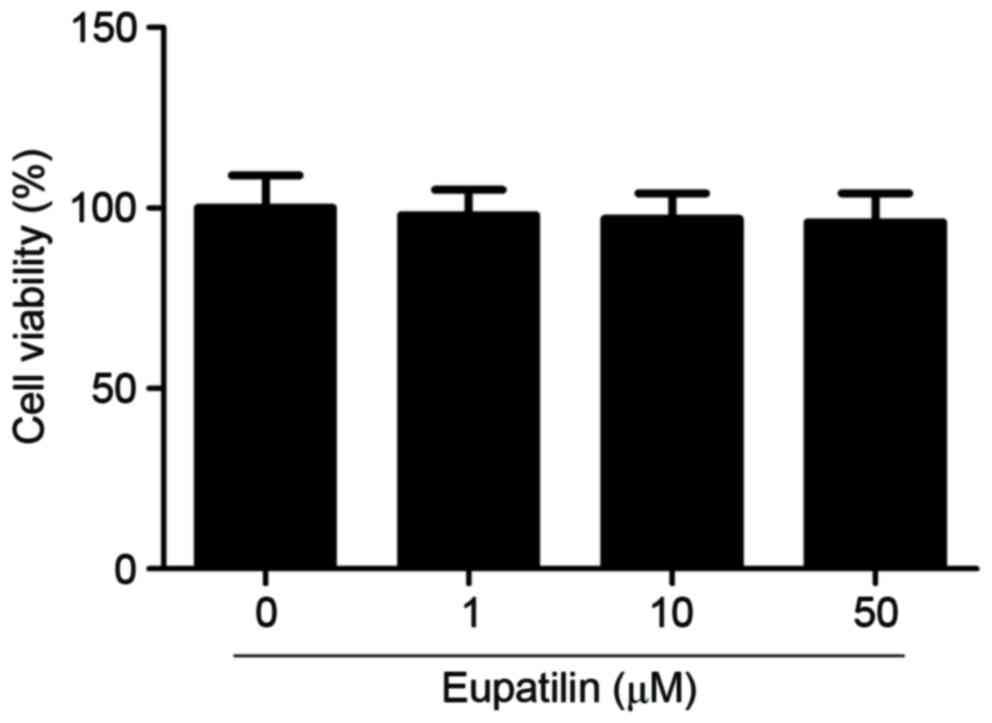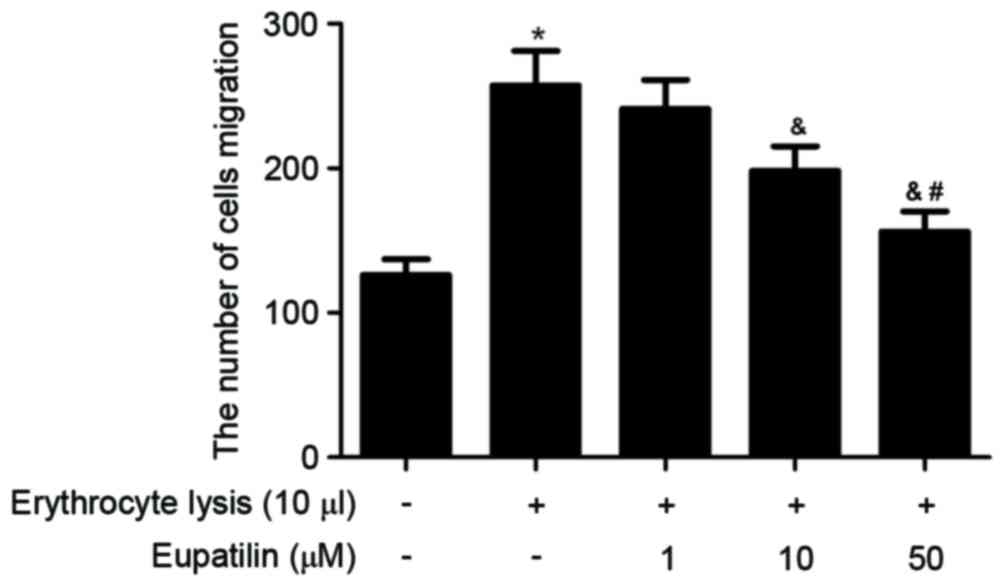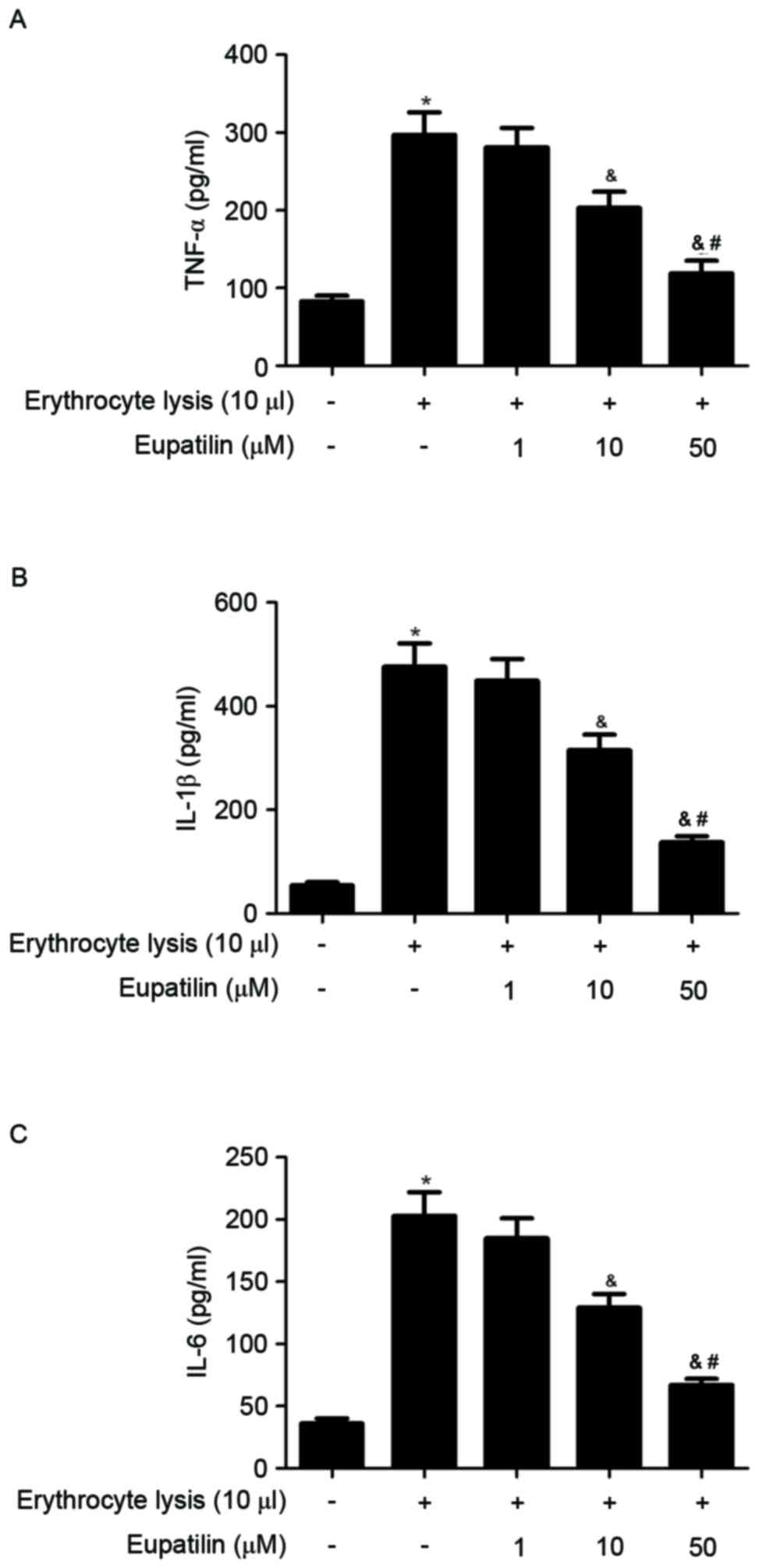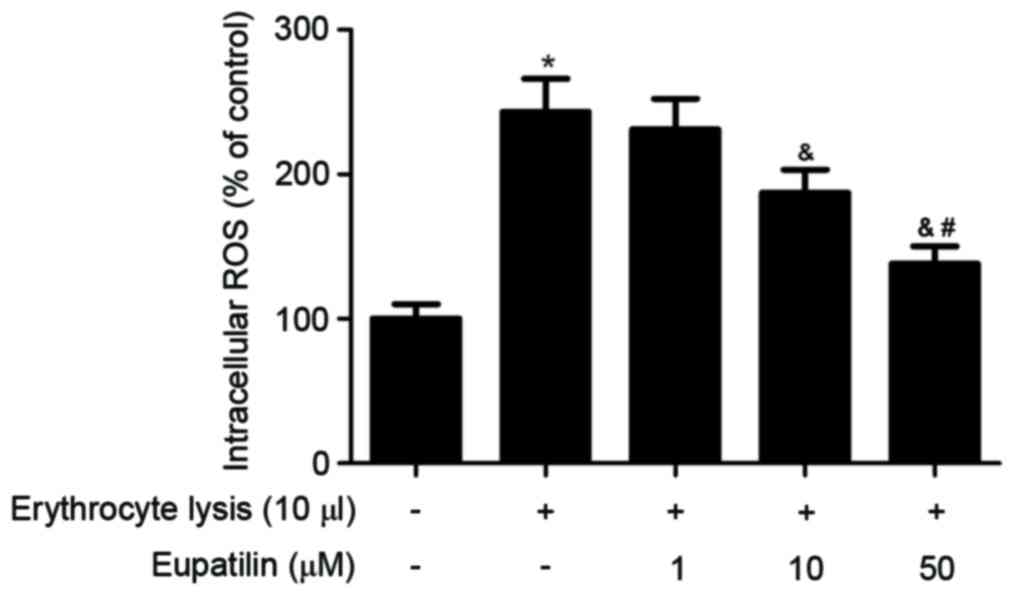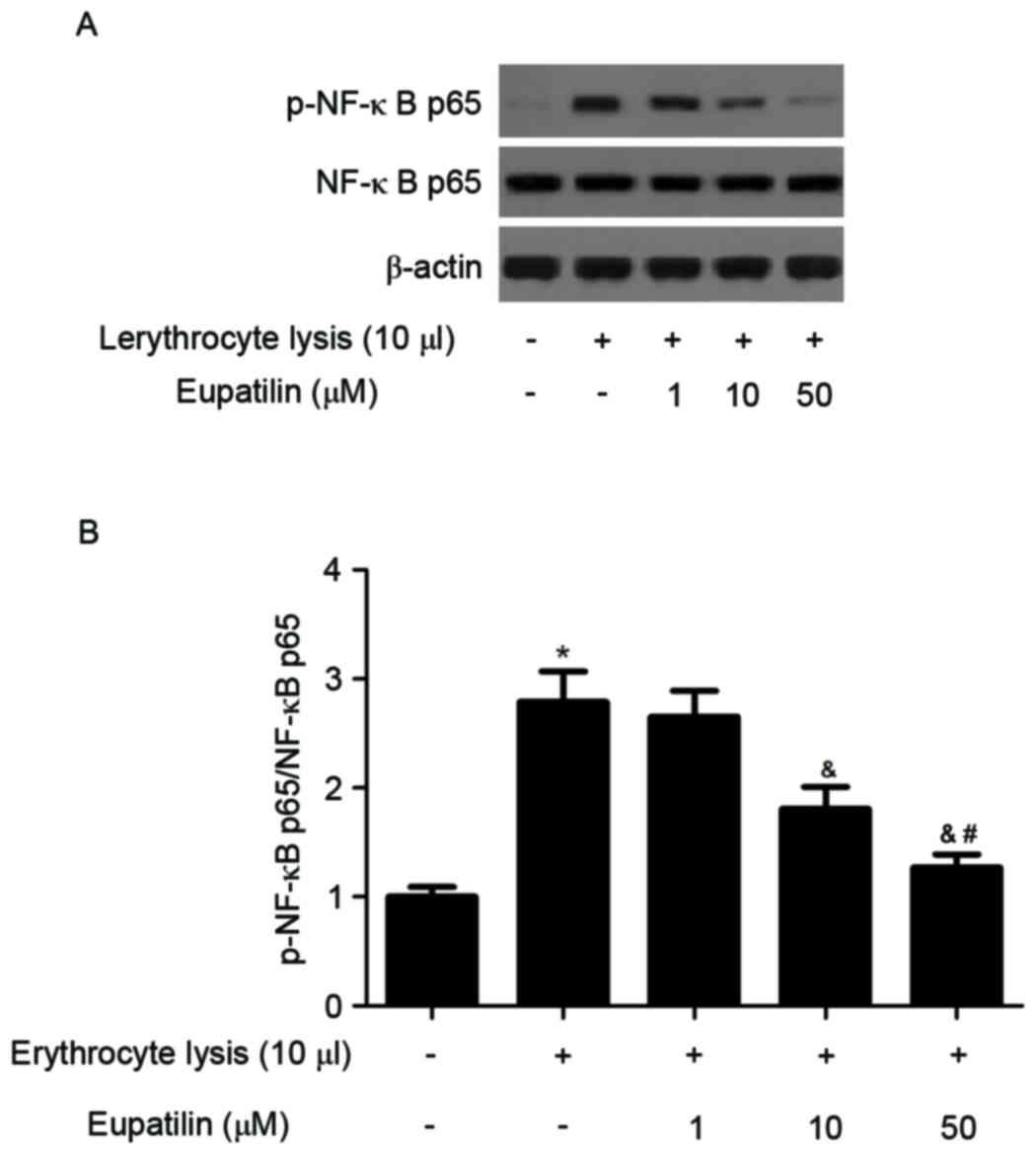Eupatilin inhibits microglia activation and attenuates brain injury in intracerebral hemorrhage
- Authors:
- Published online on: September 5, 2018 https://doi.org/10.3892/etm.2018.6699
- Pages: 4005-4009
-
Copyright: © Qiao et al. This is an open access article distributed under the terms of Creative Commons Attribution License.
Abstract
Introduction
Intracerebral hemorrhage (ICH) accounts for 10–15% of all strokes and is associated with high mortality and morbidity (1). ICH is characterized by the rupture of cerebral blood vessels and subsequent leakage of blood, including blood-intrinsic factors, into the brain parenchyma (2). Currently, no effective treatment options are available for ICH. Previous studies have reported that inflammation is a key factor that contributes to ICH-induced brain injury (2–4). It is thought that resident microglia and astrocytes are the early inflammatory cells in ICH (4). Activated inflammatory cells release a variety of cytokines, chemokines, free radicals and other potentially toxic chemicals (5–7), which further aggravate brain injury. Therefore, suppressing microglial function may be a promising novel strategy for ICH therapy.
Artemisia princeps Pampanini (family Asteraceae) is an herbal medicine widely used in Korea, China and Japan. Eupatilin, a pharmacologically active flavone derived from Artemisia sp. has been reported to have antioxidant, anti-inflammatory, anti-allergy and anti-tumor activities (8–11). Kim et al (12) reported that pre-treatment with eupatilin decreased the production of interleukin (IL)-8 and prostaglandin E2 induced by Bacteroides fragilis in HT-29 intestinal epithelial cells. Eupatilin has been reported to exert neuroprotective activities against ischemia/reperfusion-induced delayed neuronal injury in mice, increasing the number of viable cells and decreasing the number of degenerating neuronal cells in the hippocampal CA1 region (13). However, the effect of eupatilin in ICH has not been well studied. The aim of the present study was to investigate the effect of eupatilin on ICH-induced microglial inflammation.
Materials and methods
Cell culture and reagents
The murine microglial cell line BV2 was purchased from the American Type Culture Collection (ATCC, Manassas, VA, USA) and cultured in Dulbecco's Modified Eagle Medium (DMEM)/F12 supplemented with 10% fetal bovine serum (FBS; both Gibco; Thermo Fisher Scientific, Inc., Waltham, MA, USA), 2 mM glutamine, 100 U/ml penicillin and 100 mg/ml streptomycin in a humidified atmosphere containing 5% CO2 at 37°C. Eupatilin was supplied by Dong-A Pharmaceutical Co. Ltd. (Yong-In, South Korea) and dissolved in dimethylsulfoxide for treatment.
MTT assay
An MTT assay was performed to assess microglia viability. In brief, BV2 cells (1×105 cells/well) were cultured at 37°C with various concentrations of eupatilin (1, 10 or 50 µM) for 24 h. Cells were incubated with MTT solution (5 mg/ml) at 37°C for 4 h, following which dimethylsulfoxide was added and shaken at room temperature for 10 min. The optical density was determined at 570 nm using a microplate reader (Bio-Rad Laboratories, Inc., Hercules, CA, USA).
Transwell migration assay
The migration assay was performed using a Transwell system. The lower compartment was filled with 0.5 ml of DMEM containing 1% FBS with 10 µl erythrocyte lysis buffer (Wuhan Boster Biological Technology, Ltd., Wuhan, China) alone or together with eupatilin (1, 10 or 50 µM). BV2 cells (1×105 cells/well) were resuspended in 0.1 ml of DMEM and placed in the upper Transwell chamber, which was subsequently incubated for 24 h at 37°C. Cells on the lower surface of the filter were fixed with 3.7% paraformaldehyde in PBS at 37°C for 2 h. Cells were then stained with 5% crystal violet for 30 min at 37°C, washed with PBS three times at room temperature, and the migratory BV2 cells were counted under a light microscope (Olympus BX51; Olympus Corporation, Tokyo, Japan; magnification, ×200) in at least six random fields. All experiments were performed in triplicate.
ELISA
BV2 microglial cells were seeded at a density of 1×105 cells/well in 24-well tissue culture plates and cultured at 37°C with various concentrations of eupatilin (1, 10 or 50 µM) for 1 h. Subsequently, wells were stimulated with 10 µl erythrocyte lysis buffer and supernatants were removed 3 days later. Tumor necrosis factor-α (TNF-α; cat. no. MTA00B), IL-1β (cat. no. MLB00C) and IL-6 (cat. no. DY406) expression was measured using ELISA kits (R&D Systems, Inc., Minneapolis, MN, USA) according to the manufacturer's protocol. The absorbance at 450 nm was determined using a microplate reader.
Measurement of intracellular reactive oxygen species (ROS)
BV2 cells (1×105 cells/well) were pre-treated with various concentrations of eupatilin (1, 10 or 50 µM) for 1 h followed by 10 µl erythrocyte lysis buffer stimulation for 24 h. Next, 2-,7-dichlorodihydrofluorescein diacetate (H2DCF-DA, 5 µM) was added to the cells at 37°C for 20 min. Oxidation of the non-fluorescent H2DCF-DA by intracellular reactive oxygen species (ROS) results in formation of the fluorescent compound 2-,7-dichlorofluorescein (DCF). DCF mean fluorescence intensity (MFI) was monitored with a laser confocal scanning microscope (Leica Microsystems GmbH, Wetzlar, Germany).
Western blotting
BV2 cells were lysed in radioimmunoprecipitation assay buffer (50 mM Tris-HCl, pH 7.4, 150 mM NaCl, 1% NP-40, 0.5% sodium deoxycholate, and 0.1% SDS) containing protease and phosphatase inhibitors (5 mM EDTA, 1 mM PMSF, and 1 mM sodium orthovanadate) for 30 min on ice. The protein content was determined using a BCA protein assay (Pierce; Thermo Fisher Scientific, Inc.). Proteins (20 µg) were separated by 10% SDS-PAGE and transferred to polyvinylidene difluoride membranes (EMD Millipore, Billerica, MA, USA). The membranes were blocked in 5% skim milk in TBS containing 0.1% Tween-20 (TBST) for 1 h at room temperature, followed by incubation with primary antibodies: Rabbit anti-mouse p-NF-κB p65 (1:1,000; cat. no. sc-135768) and NF-κB p65 (1:1,000, cat. no. sc-71675; both Santa Cruz Biotechnology, Inc., Dallas, TX, USA) overnight at 4°C. Membranes were washed and incubated with horseradish peroxidase-conjugated secondary antibodies for 1 h at room temperature, following which bands were detected using an enhanced chemiluminescent detection kit (Thermo Fisher Scientific, Inc.) according to the manufacturer's protocol. The relative intensity of protein signals was normalized to the corresponding β-actin (1:1,000; cat. no. sc-47778; Santa Cruz Biotechnology, Inc.) intensity and was quantified by densitometric analysis using ImageQuant software (version 7.0; GE Healthcare Life Sciences, Little Chalfont, UK).
Statistical analysis
All data are presented as the mean ± standard deviation. Each experiment was repeated at least three times in triplicate, unless otherwise stated. Differences between two groups were analyzed using paired Student's t-tests. One-way analysis of variance followed by Student-Newman-Keuls post hoc test was used to compare differences between multiple groups. The results were analyzed using SPSS software (version 20.0; IBM Corp, Armonk, NY, USA). P<0.05 was considered to indicate a statistically significant difference.
Results
Effects of eupatilin on microglia viability
To investigate the effect of eupatilin on microglia viability, cells were treated with various concentrations of eupatilin (1, 10 or 50 µM). As indicated in Fig. 1, eupatilin did not significantly affect microglia viability compared with the control group.
Effects of eupatilin on microglia migration
The effect of eupatilin on microglia migration was assessed using a Transwell assay. As indicated in Fig. 2, erythrocyte lysis stimulation significantly promoted microglia migration compared with the PBS control, whereas eupatilin significantly suppressed erythrocyte lysis-induced microglia migration in a dose-dependent manner.
Effects of eupatilin on inflammation cytokine release
To assess the anti-inflammatory effects of eupatilin in ICH-induced BV2 microglia, cell culture media were collected and TNF-α, IL-1β and IL-6 levels were measured in ICH-induced BV2 cells. As indicated in Fig. 3, erythrocyte lysis stimulation significantly increased the production of TNF-α, IL-1β and IL-6, whereas eupatilin suppressed these increases cytokine in a dose-dependent manner.
Effect of eupatilin on intracellular ROS
It has previously been reported that increased intracellular ROS may serve a critical role in the progression of ICH (5). The effect of eupatilin on intracellular ROS production in BV2 cells was therefore investigated. As indicated in Fig. 4, erythrocyte lysis stimulation significantly increased the production of ROS. However, eupatilin obviously suppressed erythrocyte lysis-induced ROS production in BV2 cells.
Effect of eupatilin on NF-ĸB activation
It has been reported that NF-κB is an important regulator of cell fate and function in the nervous system (7). The effect of eupatilin on NF-κB activation was investigated using western blotting. As presented in Fig. 5, erythrocyte lysis stimulation significantly induced the expression of p-NF-κB p65, whereas eupatilin reduced erythrocyte lysis-induced NF-κB activation in BV2 cells.
Discussion
Inflammation serves a critical role in the pathophysiology of ICH-induced brain injury; however, the mechanism by which ICH stimulates the inflammatory response remains unclear. In the present study, it was demonstrated that eupatilin significantly inhibited microglial migration. It also decreased the production of inflammatory cytokines and intracellular ROS levels in erythrocyte lysis-induced BV2 cells. The anti-inflammatory mechanism of eupatilin was also assessed and the results revealed that eupatilin was able to inhibit erythrocyte lysis-induced NF-ĸB activation in BV2 cells.
Microglia are believed to serve a crucial role in the development ICH (13,14). During ICH, microglia migrate into damaged tissue to trigger inflammation and wound healing (14). It has been reported that migration and process motility are typical of activated microglia and serve to induce a number of regulated cellular functions, including cytokine production, phagocytosis and antigen production (14). Furthermore, several studies have reported that microglial migration is increased in erythrocyte lysis stimulated microglia (15,16). In the present study, it was demonstrated that erythrocyte lysis treatment promotes microglial migration, which is consistent with these previous studies. However, eupatilin significantly inhibited microglial migration.
In animal models, microglial cells are activated in the brain following ICH (16). Microglia are critical regulators of the neuron-inflammatory response and major contributors to the excessive production of pro-inflammatory cytokines (2). It has been reported that pro-inflammatory cytokines serve important roles in exacerbating ICH-induced brain injury (17). TNF-α is significantly increased in ICH models and may contribute to the formation of brain edema and brain injury (4,17), while IL-6 is a multifunctional cytokine that serves an important role in host defense and has major regulatory effects in the inflammatory response (18). The results of the present study demonstrate that erythrocyte lysis stimulation significantly increases the production of TNF-α, IL-1β and IL-6, whereas eupatilin suppresses this effect in a dose-dependent manner. These data suggest that eupatilin may be able to inhibit ICH-induced microglia mediated inflammation.
ROS production following ICH contributes to ICH pathogenesis (19). Several lines of evidence indicate that ROS serve as secondary messengers to encode and enhance the expression of pro-inflammatory factors (20,21). Furthermore, intracellular ROS accumulation in microglia has been reported to trigger the release of inflammatory mediators via the activation of signaling molecules, including mitogen-activated protein kinases and NF-κB (22). In the present study, it was reported that eupatilin downregulates erythrocyte lysis-induced intracellular ROS in BV-2 cells. These results suggest that eupatilin has a neuroprotective effect that is achieved via the inhibition of ROS production in microglia.
NF-κB serves a crucial role in regulating immunity and inflammation in central nervous system injuries, including ICH (23–25). Zhang et al (26) reported that NF-κB activation was increased in perihematomal brain tissue following ICH. It has also been suggested that NF-ĸB activation in microglia following ICH results in the upregulation of pro-inflammatory cytokines, including TNF-α and IL-1β, and contributes to brain injury (27). The present study demonstrates that eupatilin is able to prevent erythrocyte lysis-induced NF-κB activation in BV2 cells. These results suggest that the anti-inflammatory effect of eupatilin may result from inhibition of the NF-κB signaling pathway.
In conclusion, the results of the present study suggest that eupatilin serves a neurological protective effect via inhibiting microglial inflammation. The present study may provide an experimental basis for the use of eupatilin as a therapeutic target for ICH.
Acknowledgements
Not applicable.
Funding
No funding was received.
Availability of data and materials
The datasets generated and analyzed during the current study are not publicly available due to further research being performed, but are available from the corresponding author on reasonable request.
Authors' contributions
HBQ and JL designed the study. LJL, BJN, PL and FX performed the experiments. ZMZ analyzed the data.
Ethics approval and consent to participate
All patients were required to provide written informed consent prior to their inclusion. The study was approved by the Ethical Committee of Dezhou People's Hospital.
Patients' consent for publication
Not applicable.
Competing interests
The authors declare that they have no competing interests.
References
|
Huttner HB, Köhrmann M, Tognoni E, Jüttler E, Richter G, Dörfler A, Reulbach U, Bassemir T, Staykov D, Bardutzky J, et al: Clinical severity predicts time to hospital admission in patients with spontaneous intracerebral hemorrhage. Cerebrovasc Dis. 25:533–538. 2008. View Article : Google Scholar : PubMed/NCBI | |
|
Wang J: Preclinical and clinical research on inflammation after intracerebral hemorrhage. Prog Neurobiol. 92:463–477. 2010. View Article : Google Scholar : PubMed/NCBI | |
|
Zhang X, Li H, Hu S, Zhang L, Liu C, Zhu C, Liu R and Li C: Brain edema after intracerebral hemorrhage in rats: The role of inflammation. Neurol India. 54:402–407. 2006. View Article : Google Scholar : PubMed/NCBI | |
|
Wang J and Doré S: Inflammation after intracerebral hemorrhage. J Cereb Blood Flow Metab. 27:894–908. 2007. View Article : Google Scholar : PubMed/NCBI | |
|
Aronowski J and Hall CE: New horizons for primary intracerebral hemorrhage treatment: Experience from preclinical studies. Neurol Res. 27:268–279. 2005. View Article : Google Scholar : PubMed/NCBI | |
|
Gao Z, Wang J, Thiex R, Rogove A, Heppner F and Tsirka S: Microglial activation and intracerebral hemorrhage. Acta Neurochir Suppl. 105:51–53. 2008. View Article : Google Scholar : PubMed/NCBI | |
|
Wang J and Tsirka SE: Contribution of extracellular proteolysis and microglia to intracerebral hemorrhage. Neurocrit Care. 3:77–85. 2005. View Article : Google Scholar : PubMed/NCBI | |
|
Choi EJ, Oh HM, Na BR, Ramesh T, Lee HJ, Choi CS, Choi SC, Oh TY, Choi SJ, Chae JR, et al: Eupatilin protects gastric epithelial cells from oxidative damage and down-regulates genes responsible for the cellular oxidative stress. Pharm Res. 25:1355–1364. 2008. View Article : Google Scholar : PubMed/NCBI | |
|
Choi EJ, Lee S, Chae JR, Lee HS, Jun CD and Kim SH: Eupatilin inhibits lipopolysaccharide-induced expression of inflammatory mediators in macrophages. Life Sci. 88:1121–1126. 2011. View Article : Google Scholar : PubMed/NCBI | |
|
Kim JY, Kwon EY, Lee YS, Kim WB and Ro JY: Eupatilin blocks mediator release via tyrosine kinase inhibition in activated guinea pig lung mast cells. J Toxicol Environ Health A. 68:2063–2080. 2005. View Article : Google Scholar : PubMed/NCBI | |
|
Choi EJ, Oh HM, Wee H, Choi CS, Choi SC, Kim KH, Han WC, Oh TY, Kim SH and Jun CD: Eupatilin exhibits a novel anti-tumor activity through the induction of cell cycle arrest and differentiation of gastric carcinoma AGS cells. Differentiation. 77:412–423. 2009. View Article : Google Scholar : PubMed/NCBI | |
|
Kim J, Lee D, Kim J, Lee J, Park HG, Kim YJ, Oh YK, Jung H and Kim S: 5,7-dihydroxy-3,4,6-trimethoxyflavone inhibits the inflammatory effects induced by Bacteroides fragilis enterotoxin via dissociating the complex of heat shock protein 90 and I kappaB alpha and I kappaB kinase-gamma in intestinal epithelial cell culture. Clin Exp Immunol. 155:541–551. 2009. View Article : Google Scholar : PubMed/NCBI | |
|
Cai M, Phan PT, Hong JG, Kim DH, Kim JM, Park SJ, Liu X, Han JE, Park H, Choi JW and Ryu JH: The neuroprotective effect of eupatilin against ischemia/reperfusion-induced delayed neuronal damage in mice. Eur J Pharmacol. 689:104–110. 2012. View Article : Google Scholar : PubMed/NCBI | |
|
Garden GA and Möller T: Microglia biology in health and disease. J Neuroimmune Pharmacol. 1:127–137. 2006. View Article : Google Scholar : PubMed/NCBI | |
|
Yang Z, Zhao T, Zou Y, Zhang JH and Feng H: Curcumin inhibits microglia inflammation and confers neuroprotection in intracerebral hemorrhage. Immunol Lett. 160:89–95. 2014. View Article : Google Scholar : PubMed/NCBI | |
|
Yang Z, Liu Y, Yuan F, Li Z, Huang S, Shen H and Yuan B: Sinomenine inhibits microglia activation and attenuates brain injury in intracerebral hemorrhage. Mol Immunol. 60:109–114. 2014. View Article : Google Scholar : PubMed/NCBI | |
|
Lin S, Yin Q, Zhong Q, Lv FL, Zhou Y, Li JQ, Wang JZ, Su B and Yang QW: Heme activates TLR4-mediated inflammatory injury via MyD88/TRIF signaling pathway in intracerebral hemorrhage. J Neuroinflammation. 9:462012. View Article : Google Scholar : PubMed/NCBI | |
|
Burton MD, Rytych JL, Freund GG and Johnson RW: Central inhibition of interleukin-6 trans-signaling during peripheral infection reduced neuroinflammation and sickness in aged mice. Brain Behav Immun. 30:66–72. 2013. View Article : Google Scholar : PubMed/NCBI | |
|
Nakamura T, Keep RF, Hua Y, Hoff JT and Xi G: Oxidative DNA injury after experimental intracerebral hemorrhage. Brain Res. 1039:30–36. 2005. View Article : Google Scholar : PubMed/NCBI | |
|
Qin L, Liu Y, Wang T, Wei SJ, Block ML, Wilson B, Liu B and Hong JS: NADPH oxidase mediates lipopolysaccharide-induced neurotoxicity and proinflammatory gene expression in activated microglia. J Biol Chem. 279:1415–1421. 2004. View Article : Google Scholar : PubMed/NCBI | |
|
Lee IT and Yang CM: Role of NADPH oxidase/ROS in pro-inflammatory mediators-induced airway and pulmonary diseases. Biochem Pharmacol. 84:581–590. 2012. View Article : Google Scholar : PubMed/NCBI | |
|
Asehnoune K, Strassheim D, Mitra S, Kim JY and Abraham E: Involvement of reactive oxygen species in Toll-like receptor 4-dependent activation of NF-kappaB. J Immunol. 172:2522–2529. 2004. View Article : Google Scholar : PubMed/NCBI | |
|
You WC, Wang C, Pan Y, Zhang X, Zhou X, Zhang X, Shi JX and Zhou Ml: Activation of nuclear factor-κB in the brain after experimental subarachnoid hemorrhage and its potential role in delayed brain injury. PLoS One. 8:e602902013. View Article : Google Scholar : PubMed/NCBI | |
|
Koedel U, Bayerlein I, Paul R, Sporer B and Pfister H: Pharmacologic interference with NF-κB activation attenuates central nervous system complications in experimental pneumococcal meningitis. J Infect Dis. 182:1437–1445. 2000. View Article : Google Scholar : PubMed/NCBI | |
|
Kaltschmidt B and Kaltschmidt C: NF-κB in the nervous system. Cold Spring Harb Perspect Biol. 1:a0012712009. View Article : Google Scholar : PubMed/NCBI | |
|
Zhang Z, Liu Y, Huang Q, Su Y, Zhang Y, Wang G and Li F: NF-κB activation and cell death after intracerebral hemorrhage in patients. Neurol Sci. 35:1097–1102. 2014. View Article : Google Scholar : PubMed/NCBI | |
|
Wagner KR: Modeling intracerebal hemorrhage glutamate, nuclear factor-κB signaling and cytokines. Stroke. 38 Suppl 2:S753–S758. 2007. View Article : Google Scholar |



